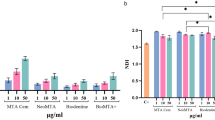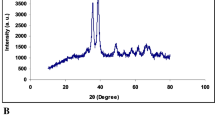Abstract
This work reports the behaviour of osteoblastic human alveolar bone cells (first subculture) in the presence of chorhexidine (CHX) and povidone–iodine (PI). Short contact (2 min) of 24-h cultures with CHX, at 0.12 and 0.2%, and PI, at 5 and 10%, caused cell death within minutes; contact with 1% PI resulted in loss of the elongated characteristic cell shape. Cell adhesion was adversely affected at concentrations higher than 5 × 10−5% CHX or 0.05% PI. Long-term exposure to CHX at 10−5 and 10−4% or PI at 10−4% had little effect on cell growth and caused an induction in the synthesis of alkaline phosphatase (ALP). Concentrations of CHX and PI similar and higher than, respectively, 5 × 10−4% or 0.05% caused dose-dependent deleterious effects. CHX affected mainly the cell growth, whereas the effects of PI were observed mostly in ALP production and matrix mineralization. Considering the levels of CHX and PI used routinely in the oral cavity, results suggest that CHX has a higher cytotoxicity profile than PI. This observation might have some clinical relevance regarding the potential utility of PI in the prevention of alveolar osteitis.





Similar content being viewed by others
References
Alexander RE (1998) Eleven miths of dentoalveolar surgery. J Am Dent Assoc 129:1271–1279
Amin MS, Harrison RL, Benton TS, Roberts M, Weinstein P (2004) Effect of povidone–iodine on Streptococcus mutans in children with extensive dental caries. Pediatr Dent 26:5–10
Amler MH (1969) The time sequence of tissue regeneration in human extraction wounds. Oral Surg 27:309
Babich H, Wurzburger BJ, Rubin YL, Sinensky MC, Blau L (1995) An in vitro study on the cytotoxicity of chlorhexidine gluconate to human gengival cells. Cell Biol Toxicol 11:79–88
Balin AK, Pratt L (2002) Dilute povidone–iodine solutions inhibit human skin fibroblast growth. Dermatol Surg 28:210–214
Bassetti C, Kallenberger A (1980) Influence of chlorhexidine rinsing on the healing of oral mucosa and osseous lesions. J Clin Periodontol 7:443–456
Bellows CG, Aubin JE, Heersche JNM (1991) Initiation and progression of mineralization of bone nodules formed in vitro: the role of alkaline phosphatase and organic phosphate. Bone Miner 14:27–40
Berridge MV, Tan AS (1993) Characterization of the cellular reduction of 3-(4,5-dimethylthiazol-2-yl)-2,5-diphenyltetrazolium bromide (MTT): subcellular location, substracte dependence, and involvement of mitochondrial electron transport in MTT reduction. Arch Biochem Biophys 303:474–482
Berwick JE, Lessin ME (1990) Effects of a chlorhexidine gluconate oral rinse on the incidence of alveolar osteitis in mandibular third molar surgery. J Oral Maxillofac Surg 48:444–448
Bhandari M, Adili A, Schemitsch EH (2001) The efficacy of low pressure lavage with different irrigating solutions to remove adherent bacteria from bone. J Bone Jt Surg 83(A):412–419
Birn H (1973) Etiology and pathogenesis of fibrinolytic alveolitis (dry socket). Int J Oral Surg 2:211–263
Blum IR (2002) Comtemporary views on dry socket (alveolar osteitis): a clinical appraisal of standardization, aetiopathogenesis and management: a critical review. Int J Oral Maxillofac Surg 31:309–317
Bonine FL (1995) Effect of chlorhexidine rinse on the incidence of dry socket in impacted mandibular third molar extraction sites. Oral Surg Oral Med Oral Pathol Oral Radiol Endod 79:154–158
Bouchlariotou I, Zahedi CS, von Ohle C, Brecx M (2001) Polyvidone iodée: activité antimicrobiene en parodontologie. J Parad Implantol Oral 21:5–12
Bragger U, Schild U, Lang NP (1994) Effect of chlorhexidine (0.12%) rinses on periodontal tissue healing after tooth extraction. (II). Radiographic parameters. J Clin Periodontol 21:422–430
Branchet MCh, Boisnic S, Pascal F, Federlin-Ducani M (1994) Action in vitro d’une solution a base de chlorhexidine a 0,1% sur la prolifération des fibroblasts et la différenciation épithéliale de muqueuse reconstituée. J de Paradontologie 13:79–86
Chen YT, Hung SL, Lin LW, Chi LY, Ling LJ (2003) Attachment of periodontal ligament cells to chlorhexidine-loaded guided tissue regeneration membranes. J Periodontol 74:1652–1659
Cline NV, Layman DL (1992) The effects of chlorhexidine on the attachment and growth of cultured human periodontal cells. J Periodontol 63:598–602
Costa MA, Fernandes MH (2000) Long-term effects of parathyroid hormone, dihydroxyvitamin D3 and dexamethasone on the cell growth and functional activity of human osteogenic alveolar bone cell cultures. Pharmacol Res 42:345–353
Dajani AS, Taubert KA, Wilson W (1997) Prevention of bacterial endocarditis: recommendation by the American Heart Association. J Am Dent Assoc 128:1142–1151
Damour O, Zhi HS, Lasne F, Villain M, Rousselle P, Collombel C (1992) Cytotoxicity evaluation of antiseptics and antibiotics on cultured human fibroblasts and keratinocytes. Burns 18:479–485
Delilbasi C, Saracoglu U, Keskin A (2002) Effects of 0.2% chlorhexidine gluconate and amoxicillin plus clavulanic acid on the prevention of alveolar osteitis following mandibular third molar extractions. Oral Surg Oral Med Oral Pathol Oral Radiol Endod 94:301–304
Elsen K, Ozmeric N, Sardas S (2002) Monitoring of buccal epithelial cells by alkaline comet assay (single cell gel electrophoresis technique) in cytogenetic evaluation of chlorhexidine. J Clin Oral Invest 6:150–154
Fernandes MH, Costa MA, Carvalho GS (1997) Mineralization in serially passaged human alveolar bone cells. J Mat Sci Mater Med 8:61–65
Gabler WL, Roberts D, Harold W (1987) The effects of chlorhexidine on blood cells. J Periodontal Res 22:150–155
Greenstein G (1999) Povidone–iodine’s effects and role in the management of periodontal diseases: a review. J Periodontol 70:1397–1405
Gwynn IAP (1994) Cell biology at interfaces. J Mat Sci Mater Med 5:357–360
Hoang T, Jorgensen MG, Keim RG, Pattison AM, Slots J (2003) Povidone–iodine as a periodontal pocket disinfectant. J Periodontal Res 38:311–317
Kaysinger KK, Nicholson NC, Ramp WK, Kellam JF (1995) Toxic effects of wound irrigation solutions on cultured tibiae and osteoblasts. J Orthop Trauma 9:303–311
Lopez L, Berkowitz R, Spiekerman C, Weinstein P (2002) Topical antimicrobial therapy in the prevention of early childwood caries: A follow-up report. Pediatr Dent 24:204–206
Loukota RA (1991) The effect of pre-operative perioral skin preparation with aqueous povidone–iodine on the incidence of infection after third molar removal. Br J Oral Maxillofac Surg 29:336–337
MacGregor AJ, Hart P (1970) Bacteria of the extraction wound. J Oral Surg 28:885–887
Mariotti AJ, Rumpf D (1999) Chlorhexidine-induced changes to human gingival fibroblasts collagen and non-collagen protein production. J Periodontol 70:1443–1448
Nefussi J-R, Casamajor P, Serfaty R, Bolle M, Hugly C, Forest N (1998) Activated adult human alveolar bone cells: a new model of matrix mineralization. Eur J Oral Sci 106(Suppl 1):424–428
Osbom TP, Frederickson G, Small IA, Torgerson TS (1985) A prospective study of complications related to mandibular third molar surgery. J Oral Maxillofac Surg 43:767–769
Pucher JJ, Daniel JC (1992) The effects of chlorhexidine digluconate on human fibroblasts in vitro. J Periodontol 63:526–532
Rahn R, Schneiders, Diehl O, Schafer V, Shah P (1995) Preventing pot-treatment bacteriemia: comparing topical povidone iodine and chlorhexidine. J Am Dental Ass 126:1145–1149
Ribeiro DA, Bazo AP, da Silva Franchi CA, Marques MEA, Salvadori DMF (2004) Chlorhexidine induces DNA damage in rat peripheral leukocytes and oral mucosal cells. J Periodontal Res 39:358–361
Rosling B, Hellstrom M-K, Ramberg P, Socransky SS, Lindhe J (2001) The use of PVP-iodine as an adjunct to non-surgical treatment of chronic periodontitis. J Clin Periodontol 28:1023–1031
Sanchez IR, Nusbaum KE, Swaim SF, Hale AS, Henderson RA, Mcguire JA (1988) Chlorhexidine diacetate and povidone–iodine cytotoxicity to canine embryonic fibroblasts and Staphylococcus aureus. Vet Surg 17:182–185
Segura JJ, Jiménez-Rubio A, Guerrero JM, Calvo JR (1999) Comparative effects of two endodontic irrigants, chlorhexidine digluconate and sodium hypochlorite on macrophage adhesion to plastic surfaces. J Endod 25:243–246
Seymour RA, Heasman PA, MacGregor IDM (1992) Anti-plaque and anti-calculus agents. In: Seymour RA, Heasman PA (eds) Drugs, diseases and the periodontium. Oxford Medical Publications, Hong Kong, pp 153–179
Shahan MH, Chuang AH, Brennan WA, Dirksen TR, van Dyke TE, Mcpherson JC (1993) The effect of chlorhexidine irrigation on tensile wound strength. J Periodontol 64:719–722
Slots J (2002) Selection of antimicrobial agents in periodontal therapy. J Periodontal Res 37:389–398
Stein GS, Lian JB, Stein JL, van Wijnen AJ, Frenkel B, Montecino M (1996) Mechanisms regulating osteoblast proliferation and differentiation. In: Bilizikian JP, Raisz LG, Rodan GA (eds) Principles of bone biology. Academic, New York, pp 69–86
Swanson AE (1990) Prevention of dry sockect: an overview. Oral Surg Oral Med Oral Pathol 70:131–136
Sweet JB, Macynski AA (1985) Effect of antimicrobial mouth rinses on the incidence of localized alveolitis and infection following mandibular third molar oral surgery. Oral Surg Oral Med Oral Pathol 59:24–26
Tatnal FM, Leighim, Gibson JR (1990) Comparative study of antiseptic toxicity on basal keratinocytes, tranformed human keratinocytes and fibroblasts. Skin Pharmacol 3:157–163
Teepe RG, Koebrugge EJ, Lowik CW, Petit PL, Bosboom RW, Twiss IM, Boxma H, Vermeer BJ, Ponec M (1993) Cytotoxic effects of topical antimicrobial and antiseptic agents on human keratinocytes in vitro. J Trauma 35:8–19
Wilken R, Botha SJ, Grober A, Germishuys PJ (2001) In vitro cytotoxicity of chlorhexidine gluconate, benzydamine-HCL and povidone iodine mouthrinses on human gingival fibroblasts. SADJ 56:455–460
Acknowledgment
This work was supported by Faculdade de Medicina Dentária da Universidade do Porto, Portugal.
Author information
Authors and Affiliations
Corresponding author
Rights and permissions
About this article
Cite this article
Cabral, C.T., Fernandes, M.H. In vitro comparison of chlorhexidine and povidone–iodine on the long-term proliferation and functional activity of human alveolar bone cells. Clin Oral Invest 11, 155–164 (2007). https://doi.org/10.1007/s00784-006-0094-8
Received:
Accepted:
Published:
Issue Date:
DOI: https://doi.org/10.1007/s00784-006-0094-8




